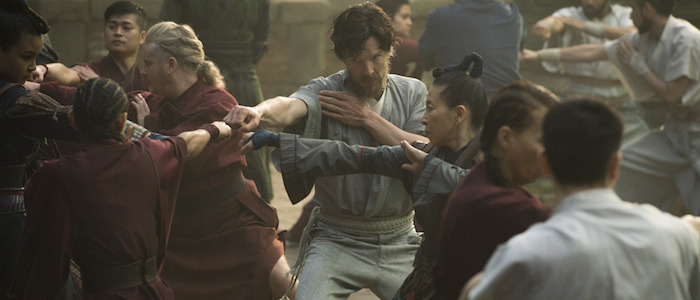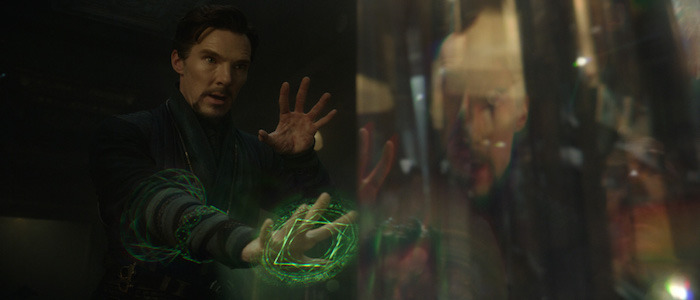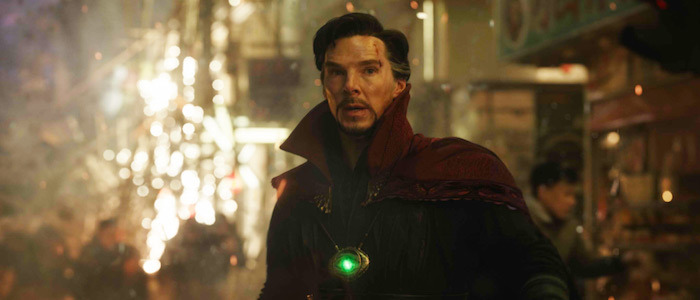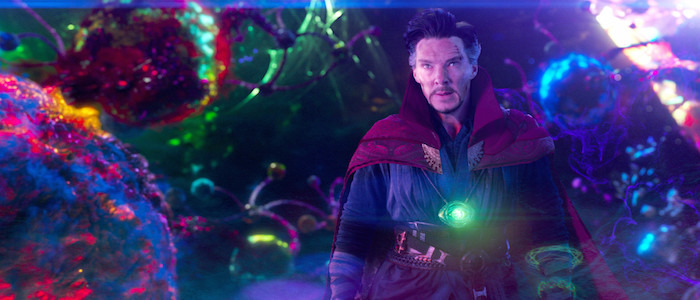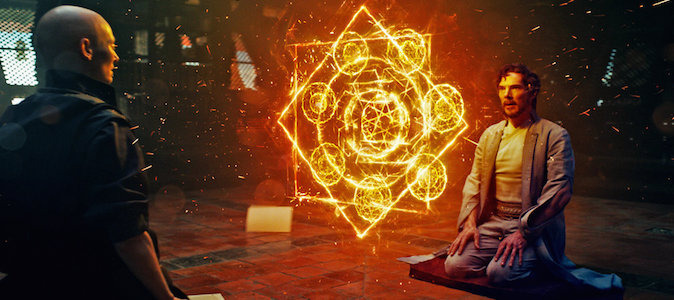Road To Endgame: 'Doctor Strange' Is A Visually Stunning Superhero Tale About Accepting Pain And Failure
(Welcome to Road to Endgame, where we revisit the first 22 movies of the Marvel Cinematic Universe and ask "How did we get here?" In this edition: Marvel Studios enters spiritual territory with Doctor Strange.)Stephen Strange (Benedict Cumberbatch) adheres to Hollywood's orientalist "white saviour" tradition, and Doctor Strange even whitewashes an already complicated Tibetan character, The Ancient One — an issue that has since been discussed from all angles (including by the director). However, in other, less apparent ways, the film proved to be Marvel's first step into a larger world, one outside the series' American and western defaults.Marvel Studios had seen the occasional non-American setting thus far; London in Thor: The Dark World, South Korea in Avengers: Age of Ultron, various vaguely Middle Eastern towns in Iron Man. Doctor Strange however, felt like the beginning of a more noteworthy trend, one wherein not just the locations, but the creative viewpoints felt fresh.The series' shift in artistic worldview continued noticeably through the likes of Thor: Ragnarok and Black Panther (and more subtly with Guardians of the Galaxy Vol. 2), with Marvel slowly beginning to cater to a wider array of perspectives. The MCU began to introduce ideas that felt more eastern, more non-white and more postcolonial in approach, rather than the series continuing its bad habit of harping half-heartedly on American militarism.The Marvel Cinematic Universe began as military propaganda eight years prior. Iron Man, the first film in the series, was subsidized by the U.S. Department of Defense, and thus, its script had to be military-approved (as was the case with Iron Man 2, Captain America: The Winter Soldier and Captain Marvel). By 2016, the MCU had evolved into a landscape-dominating phenomenon, for better and for worse. On the "better" side lies Doctor Strange which, despite the film's white, western gaze towards some of its characters, is not only aesthetically alluring, but employs eastern philosophies like Buddhism and Taoism to build its narrative framework — a far cry from the way most Hollywood stories are told.
The Western Hero
Stephen Strange has a complicated relationship to western storytelling. On one hand, he's part of the decades-old problem of Asian erasure, narratives in which Asian settings and supporting casts serve as fodder for white men's self-discovery. On the other, this particular incarnation of Strange works within that problematic framework, aiming to bridge a gap in narrative approach. Strange travels to Nepal out of desire to master the physical. Bodily healing, to be specific, though it's thematically comparable to the physical combat learned in Batman Begins, Iron Fist, Arrow and The Last Samurai, among countless other tales of white men traveling east and becoming "chosen" figures.In Doctor Strange however, Stephen Strange is made to unlearn his narrative preconceptions. He is pushed, instead, toward more complex forms of spiritual harmony, which exist beyond the physical.The western action hero, as it relates to these Eastern settings, goes hand-in-hand with the idea of Manifest Destiny (through centuries of cultural absorption, if not direct intent). Whatever forms western individualism and American exceptionalism take in the real world, in a narrative context, they're usually dramatized as personal power, rather than personal freedom. In genre storytelling, they're often forms of domination, born from self-determination rather than harmony or self-actualization.Robert J. Miller lists the tenets of Manifest Destiny — relating to the historical conquering of Native Americans — as white Americans' belief in "special virtues of the American people and their institutions," their mission to "remake the world in the image of America" and most pertinently, "a divine destiny under God's direction." While few western action films adhere to each specific tenet in an exact historical context, the core idea has bled into and influenced American stories for centuries (for example, the Western). The idea is ingrained to the point of being a subconscious default; even Captain America: The Winter Soldier, arguably the best Marvel film until this point, centers on a white man draped in an American flag, defeating an evil empire through physical strength.Countless stories, from Rudyard Kipling's The Man Who Would Be King (1888) to Netflix's The Outsider (2018) feature white westerners infiltrating, dominating and sometimes even improving upon Eastern structures, while countless more tell similar tales even without Asian settings. Your average American action movie, including those in the Marvel saga, tends to pivot around an ethos and screenplay structure wherein "overcoming" a flaw is indecipherable from physically besting an opponent and establishing individual superiority.Iron Man shuts down his weapons manufacture, but his arc culminates when he punches a bigger Iron Man. The Hulk is stronger than The Abomination, Thor is stronger than Loki, and even the Guardians of the Galaxy join hands to control the Power Stone, a symbol of physical might. All justifiable in context, no doubt, but all framed within narratives where character arcs serve physical domination, while deaths of nameless henchmen and side characters are treated as casual inevitability.Doctor Strange, on the other hand, circumvents this call to greater physical power by telling a story about the understanding of the self. At first, Stephen Strange sees magic as a means to heal his hands (rather than to do battle), though even this initial goal is distinctly physical and material, since he hopes to return to his glory days of being a rich and famous surgeon. This is tied to Strange's egocentric individualism, an outlook that values western medicine over apparently incompatible Eastern spirituality.When the villain Kaecillius (Mads Mikkelsen) finally tells Strange the story of Dormammu — an evil force promising eternal life — Strange isn't tempted to stray from his path. Were this story about learning to deal with power, this lack of temptation would be a fatal flaw. However, by the time Strange hears of Dormammu, he's also begun to forego all selfish desire. An hour into the film, Strange has learned to seek not strength, but knowledge. His training in Kathmandu involves demolishing the mental walls put in place by western structures, thus allowing him a fuller understanding of spiritual viewpoints — even if those viewpoints are a Hollywood hodgepodge of varying Eastern spiritualties.Strange's self-doubt comes not through temptation to power, but through recognition of the power he already wields. After physically besting one of Kaecillius' disciples (Scott Adkins), Strange immediately checks his pulse. The henchman is dead, and Strange is visibly upset by his own actions. When asked by Mordo (Chiwetel Ejiofor) and the Ancient One (Tilda Swinton) if he'll join them in protecting the multiverse, Strange refuses, and wonders whether the power to kill is something he should even possess in the first place.
Healing Death
A surgeon in his previous life, albeit fueled by ego, Strange's core is that of a healer rather than a fighter. The death of a single character — even a disposable redshirt — weighs on his soul. For the first time, rather than treating death with casual indifference, the Marvel Cinematic Universe places an inherent importance on human life.Stephen Strange collects fancy watches the way Tony Stark collects armour. However, when confronted with an especially risky surgery, Strange asks his colleague Nicodemus West (Michael Stuhlbarg) to cover up his wristwatch. Its ticking is a reminder of his potential for failure, the very same potential that makes Strange turn down medical cases that seem hopeless or unglamourous.Strange wants to heal people, but only on his own terms. He may be a doctor, with two of the steadiest hands in western medicine, but he's in it for the glory. He has no time for failure, and how he spends his time and money are geared towards a single goal: himself.Time is key in Doctor Strange. This is the first Marvel film to weave an Infinity Stone into its thematic fabric (the comics' Eye of Agomotto is revealed to be the Time Stone), as the heroes and villains all fight their own battles with time. When Strange's accident leaves him without full use of his hands, other people simply become a means to an end. As time goes by, recovery begins to seem unlikely. The less someone can help Strange physically — like Christine Palmer (Rachel McAdams) — the more disposable they become to him. Strange has no time for their feelings, no patience for their pity, and no care for those who can't aid his recovery. The more they fail to help him, the more he wallows in his own failure, the very feeling he's spent his career avoiding.The Ancient One, Strange's clairvoyant mentor, has her own troubles dealing with time and failure. She's spent her whole life — several centuries, in fact — trying to change the future she envisions. No matter what catastrophes she prevents, every possible outcome she predicts ends the same way: in the moment of her death, an inevitability Strange seems to encounter in Avengers: Infinity War.Like her former student Kaecillius, a man tormented by the death of his family, The Ancient One seeks a path to eternal life. And while she eventually comes to terms with her mortality, Kaecillius keeps attempting to open Dormammu's "Dark Dimension" in the hopes of eliminating time, and thus death, entirely.Like Kaecillius and The Ancient One, Strange, too, tries to bargain. At first, with the limitations of time. Then, using time as a weapon.
The Selfish Mister Doctor
As the Ancient One breathes her last, she stretches out the moment of her death. Lightning slows to a halt. A second become an eternity. Like Ho Yinsen to Tony Stark, and Abraham Erskine to Steve Rogers, the Ancient One leaves Strange with one final lesson before she departs: "It's not about you."This world of warriors is not Strange's narrative to own. His tale is not one of mastering combat, or even mastering death, but of accepting pain and failure so he can work in service of others. As the Ancient One accepts her death, she lays two choices before Strange. He can either go by way of Jonathan Pangborn (Benjamin Bratt), the miraculously recovered paraplegic who set Strange on his journey — he can return to the west as Pangborn did, pretending to fix his hands the way Pangborn uses magic to walk, resuming his futile attempts to control death for the sake of personal glory — or, Strange can stay on his new path, continuing to learn, to heal, and to accept death and failure as a part of life (perhaps even experiences that give life meaning), as he expands his worldview beyond what he thought he knew. Like Siddhartha Gautama, the first Buddha, he can give up material gain and find new ways to help humanity.Stephen Strange has spent a lifetime learning. It's what separates him from Tony Stark, who repeats mistakes in new iterations. Strange's photographic memory assists with both medical diagnoses and pop culture tidbits, which he initially uses to embarrass his colleagues. He continues his quest for knowledge at Kamar Taj, sleeping while his Astral self remains awake to read. He learns fact after fact and skill after skill, but it takes the Ancient One's passing for him to learn new wisdom.The Ancient One's death-anxiety reflects Strange's biggest fears. They form a continuum, an endless cycle of fears of mortality and failure, two forces bound by time that neither character can control or bargain with. In accepting these forces as natural, even spiritual, Strange is able to fulfill his role as a saviour.
I’ve Come to Bargain
When Dormammu makes his way to Earth, Strange confronts him after the requisite third-Act mayhem. However, the destruction of Hong Kong — which would be a "trailer moment" climax in any other Marvel film — takes place entirely off-screen.Strange uses the Time Stone to undo the carnage. The damage to property, and loss of life, all flow in reverse, as if in direct opposition to the modern Hollywood blockbuster. Bit by bit, fallen structures begin to stand, and people's wounds begin to heal. Strange becomes a healer on a vast and mystical scale, albeit by meddling with natural lawA future problem posed by Time Stone, a device that can undo death itself, is one of dramatic stakes. The Marvel movies already treat death as a non-factor, so in order to ensure narrative integrity here, Strange is confronted by Mordo, to whom the idea of bargaining with death (as the Ancient One did) is a step too far. In Strange's next major appearance, Avengers Infinity War, he refuses to let the Time Stone fall to anyone who might use it this way — at least, for as long as he can. He crosses a vital ethical boundary in Doctor Strange, and seemingly takes an oath to never do so again. The next time around, Thanos, the villain, is the one trying to turn back time.Following the healing of Hong Kong, Strange travels directly into the Dark Dimension, a world where Dormammu has transcended time and attained immortality. In order to defeat Dormammu, Strange introduces Dormammu to time itself. Time, once Strange's enemy, and the enemy of all who fear death or seek eternal life, is now his ally, despite the suffering it brings. Strange uses the Stone to create a time loop, beginning with his challenge of "Dormammu, I've come to bargain," and ending in his own death.Strange shows up to bargain. He challenges Dormammu. He fails. He is killed, painfully and violently. The loop begins anew.He shows up to bargain. He challenges Dormammu. Failure, pain and death — ad infinitum.We see the loop play out a few dozen ways, but Strange may have lived out this moment hundreds or even thousands of times. He traps Dormammu in a perpetual cycle, wherein Strange is prepared to experience pain and failure in infinite permutations. If Dormammu wants to be unbound by time, he must accept Strange's bargain of taking Kaecillius and leaving Earth for good.
Eastern Philosophies
Through his newfound wisdom, and his acceptance of pain, Strange attains a form of moksha or nirvana, the Hindu, Buddhist and Jain concept of release from perpetual cycles of death and rebirth — literalized through his battle with Dormammu — a state of being achieved through enlightenment. Strange not only find ways to heal people without the physical use of his hands, he also overcomes his fear of failure. Not by finding perpetual success, the kind that once hinged on money and adoration, but by being unafraid to fail for all eternity.In the end, Strange accepts his broken hands. His watch, once a symbol of status, is now cracked from his accident. A reminder that he can control neither time nor pain, but can only accept them as inevitable. Over the course of the film, Strange embodies all three pillars of Taosim: "frugality" by fixing wasteful destruction, "compassion" by working in service of others, and "humility" by accepting personal failure in favour of glory. His journey is one of opening up to new ideas, whether accepting philosophical outlooks that fulfill him spiritually (rather than materially), or accepting the existence of mind-bending mirror dimensions, which make the film's action a unique visual treat.The film's kaleidoscopic effects draw heavily from Steve Ditko's original designs. It features parallel worlds and new visual possibilities, along with an underlying ideology that marked Marvel's new approach to western blockbusters — the kind of approach we'd begin to see more of on the road to Avengers: Endgame.
***
Expanded from an article published April 19, 2018.

